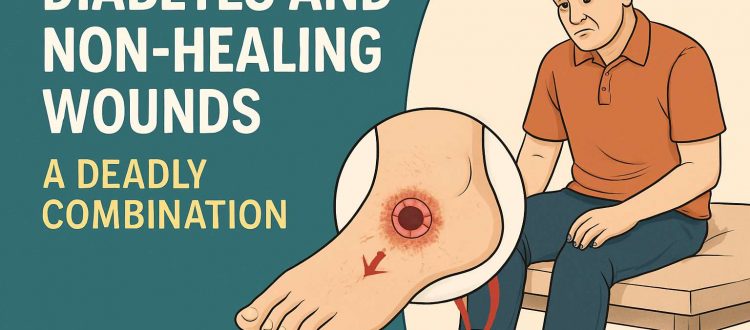Diabetes and Non-Healing Wounds: A Deadly Combination
Introduction
What if a small blister on your foot could lead to an amputation? For many living with diabetes, this frightening scenario is all too real. Diabetes and non-healing wounds form a deadly combination that can transform minor injuries into life-altering complications. With millions affected globally, understanding the causes, signs, and solutions is critical. This article offers practical insights to help patients, caregivers, and families stay ahead of this dangerous duo.
Table of Contents:
- Why Diabetes Delays Wound Healing
- Warning Signs to Watch For
- Prevention and Daily Wound Care Tips
- When to Call a Doctor
- FAQs
Why Diabetes Delays Wound Healing
The link between diabetes and non-healing wounds lies in how high blood sugar affects the body. Chronically elevated glucose levels damage blood vessels and reduce blood flow. This poor circulation prevents essential oxygen and nutrients from reaching wounds, significantly slowing the healing process. Additionally, diabetes compromises immune function, making it harder for the body to fight off infections.
Peripheral neuropathy—a common complication of diabetes—adds another layer of risk. When nerves are damaged, patients may not notice a cut, sore, or blister until it has worsened. The result? A small wound can become infected, ulcerate, and eventually require advanced treatment or even amputation. According to the American Diabetes Association, foot ulcers are the leading cause of diabetes-related hospitalizations.
Warning Signs to Watch For
Recognizing the early signs of non-healing wounds can save limbs—and lives. Look out for wounds that do not improve within 10 to 14 days. If you see swelling, redness, or fluid drainage, these could be signs of infection. Wounds that darken or emit foul odors may also indicate tissue death or gangrene.
Pain, tingling, or numbness in the feet could signal underlying neuropathy. If a person with diabetes develops these symptoms, they should increase self-monitoring of the skin. Visual inspections, especially of the feet and legs, are essential. Unfortunately, some patients assume that if a wound doesn’t hurt, it’s not serious. In fact, the opposite may be true when neuropathy is involved.
Health information communities like HealingWell.com often provide helpful experiences and discussions among patients facing similar issues. However, persistent or worsening symptoms require prompt clinical attention.
Prevention and Daily Wound Care Tips
Preventing complications from diabetes and non-healing wounds starts with daily habits. Blood sugar control is the single most important factor. Patients should monitor their glucose levels regularly and follow medical advice, including using insulin or drugs like Ozempic, Jardiance, or Farxiga if prescribed.
Foot care is critical. Wash feet daily with warm water and mild soap, and dry them gently—especially between the toes. Apply moisturizing lotion to prevent cracks, but avoid the areas between toes, as excess moisture can promote fungal infections. Always wear shoes indoors and outdoors to reduce injury risks.
Check shoes for debris or sharp objects before putting them on. Trim toenails carefully and see a podiatrist for calluses or ingrown nails. Use a mirror or ask for help when inspecting hard-to-see areas. Even minor blisters or cuts should be cleaned promptly, treated with antibiotic ointment, and covered with a sterile dressing.
If a wound shows signs of infection or doesn’t improve, contact a healthcare provider. Trusted resources like Healthcare.pro can connect you with medical professionals trained in diabetic wound care.
When to Call a Doctor
Sometimes, even the best prevention isn’t enough. Knowing when to seek help can make the difference between recovery and long-term damage. If a wound appears red, hot, or swollen, these are classic signs of infection. Likewise, if there’s pus, an unusual odor, or spreading discoloration, medical evaluation is critical.
Fever or chills can indicate that the infection is spreading. Any increase in pain, even without visible signs, may reflect deeper tissue damage. If a wound persists for more than two weeks without improvement, don’t wait—see a specialist.
Doctors may use advanced treatments like debridement, specialized dressings, negative pressure therapy, or even skin grafts. In severe cases, hospitalization or surgery may be required. The key is early intervention. Delays increase the risk of systemic infections or amputations, especially among those with poor glucose control.
Diabetes doesn’t have to lead to disaster, but it demands vigilance. Through proactive care and expert support, patients can reduce risks and maintain their quality of life.
FAQs
Why are wounds slower to heal in people with diabetes?
Diabetes impairs circulation and immune function, both of which are essential for wound healing.
What is the biggest danger of a non-healing wound?
The greatest risk is infection that can spread to the bone or bloodstream, potentially leading to amputation or sepsis.
How can I prevent diabetic wounds from getting worse?
Maintain good blood sugar control, practice daily foot care, and treat any wounds promptly and properly.
Is it safe to treat diabetic wounds at home?
Minor wounds can be managed at home, but if there’s no improvement in 10-14 days, see a healthcare provider immediately.
Where can I find support and resources?
Sites like HealingWell and platforms such as Healthcare.pro offer education, tools, and access to medical professionals.
Disclaimer:
“This content is not medical advice. For any health issues, always consult a healthcare professional. In an emergency, call 911 or your local emergency services.”

